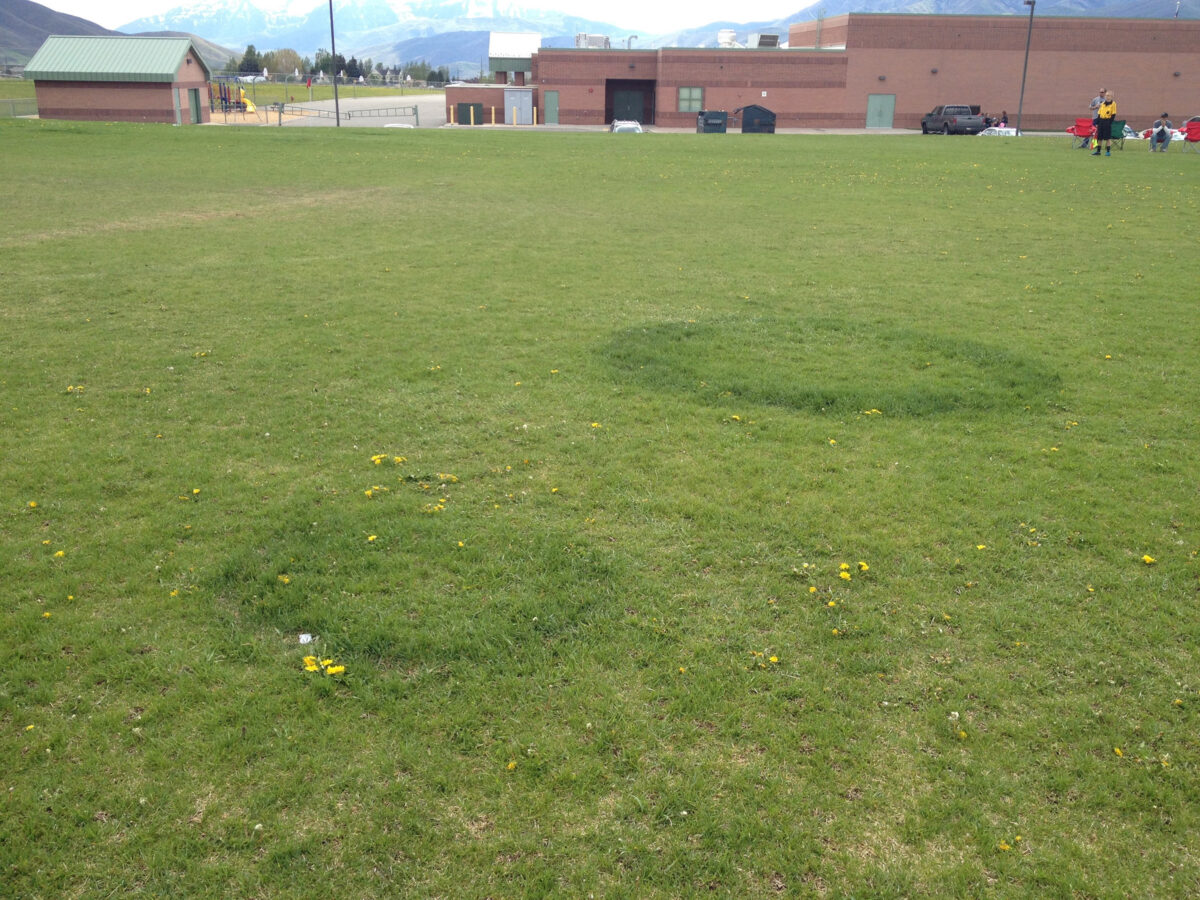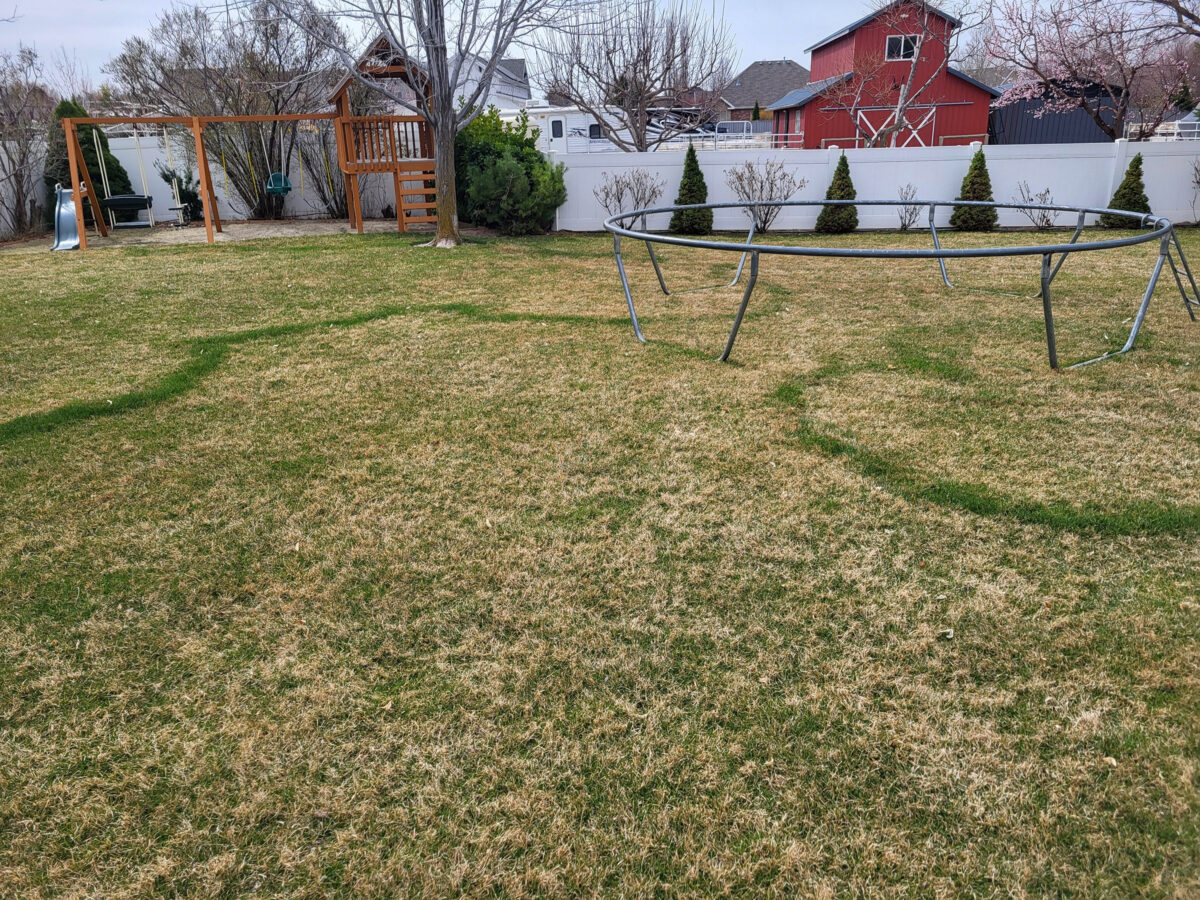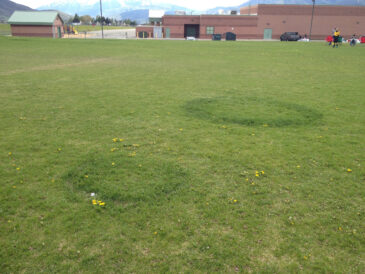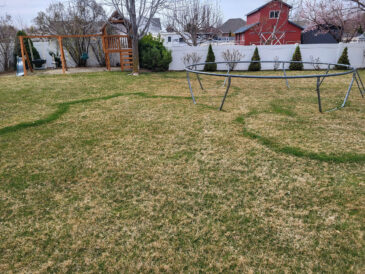Garden Help Desk: Weather forecast, not calendar, determines planting time
- This tomato transplant suffered cold injury even though it was planted out in the garden nearly 10 days after Mother’s Day.
- Both Type 1 (lower) and Type 2 (upper) fairy rings can be seen on this athletic field. Proper watering, yearly core aeration and adequate nitrogen fertilizer can improve the appearance of turf like this.
- Fairy rings like these can be masked by applying some extra nitrogen to the rest of the lawn. Remember, enough is good, but a lot more isn’t better.

Courtesy Meredith Seaver, USU Extension
This tomato transplant suffered cold injury even though it was planted out in the garden nearly 10 days after Mother’s Day.
It’s almost Mother’s Day. Can I plant my tomato and pepper transplants out in my garden now?
When to plant tender plants like tomatoes and peppers depends more on where you’re gardening and what the weather forecast tells you than on what the calendar tells you.
Mother’s Day is a traditional benchmark for some gardeners, but even though many gardens are no longer having frosty overnight temperatures, that doesn’t mean conditions are right for our tender, warm-season plants. If soils are still cold (below 50 degrees) and overnight lows are in the low to mid-40s, many transplants will sit in the garden without any real growth, waiting for better conditions. Your most tender plants may not die, but they can be injured by temperatures below 43 to 45 degrees for more than a brief time. This cold injury can delay growth once the weather warms and can even reduce yields for some varieties.
Here are some pointers for making your own decisions about when to move transplants to the garden.
- Learn the traditional last frost date for your location: https://climate.usu.edu/reports/newFreezeDates.php.
- Keep in mind that it’s not unusual to have a surprise frost after we have had many days or even a week or two of good planting weather. Even though you don’t want to bother with nightly frost protection, decide before planting how you will protect your young plants if the forecast looks iffy.
- Once your location has had a few days of good weather, start watching the 10-day forecast, looking for a solid stretch of nights with temperatures in the mid-40s. Be patient! Don’t rush your plants into the garden. When you can see 10 days of good planting weather, you’re probably fine to plant your tender plants without frost protection.
Can you tell me what is going on in my lawn? What animal is doing this and how can I control it?

Courtesy Meredith Seaver, USU Extension
Both Type 1 (lower) and Type 2 (upper) fairy rings can be seen on this athletic field. Proper watering, yearly core aeration and adequate nitrogen fertilizer can improve the appearance of turf like this.
From what I can see in your photos, the culprit here is a fungal disorder called fairy ring, not an animal. The fairy ring fungus is a large group of fungi, not a single fungus.
Fairy rings are more common in under-managed lawns and lawns that have been under-watered and under-fertilized. Lawns with thick thatch or soils with dead tree roots or other buried organic matter are also more susceptible to fairy ring growth because the thatch and buried organic matter are abundant food sources for that group of fungi.
Why do these fungi grow in ring patterns? This large group of fungi begins growth as a single underground spore that sends out hyphae (thin thread-like structures) in all directions in the soil. Over time, these rings expand and eventually outgrow themselves, but it can take more than a few seasons in many cases.
There are three different types of fairy rings.
Fairy ring fungal activity can cause soil to “repel” water. The affected grass becomes drought-stressed and dies, leaving dead circles in the lawn. These fairy rings, not often seen in home lawns, are called Type 1 fairy rings. Core aeration and slow, deep irrigation can help.

Courtesy Meredith Seaver, USU Extension
Fairy rings like these can be masked by applying some extra nitrogen to the rest of the lawn. Remember, enough is good, but a lot more isn’t better.
The fairy rings in your photo are Type 2 fairy rings, caused when abundant nitrogen is released into the soil as the fungus breaks down organic matter. With the extra nitrogen, the grass within the fairy ring will grow quickly and be lush and green.
Instead of rings of dead grass, Type 3 fairy rings look like circles of mushrooms in the lawn. They generally show up after there has been some rain. The mushrooms are the above-ground fruiting bodies of the fungi that are busy breaking down organic material in the soil. Hand-picking plus disposing of the mushrooms is the solution for these fairy rings.
The best course of action for the dark green fairy rings in your lawn is to make sure you water deeply about twice a week during the summer and less often in the spring and fall once the watering season begins in a few weeks. You can mask the fairy ring by giving your lawn some additional nitrogen. Core aerating the lawn will also be helpful if the thatch layer is more than 1/2 inch thick. Fungicides are of little benefit.



